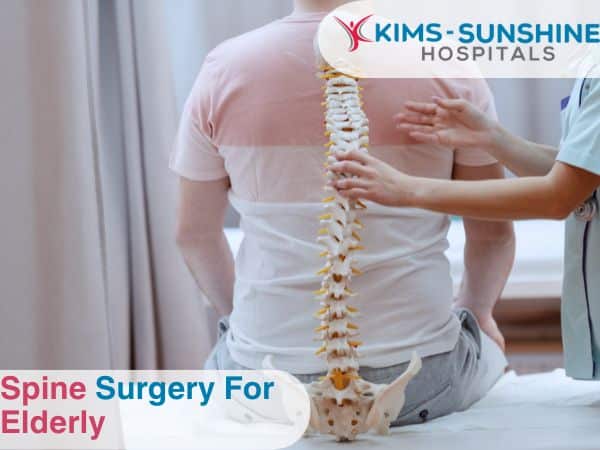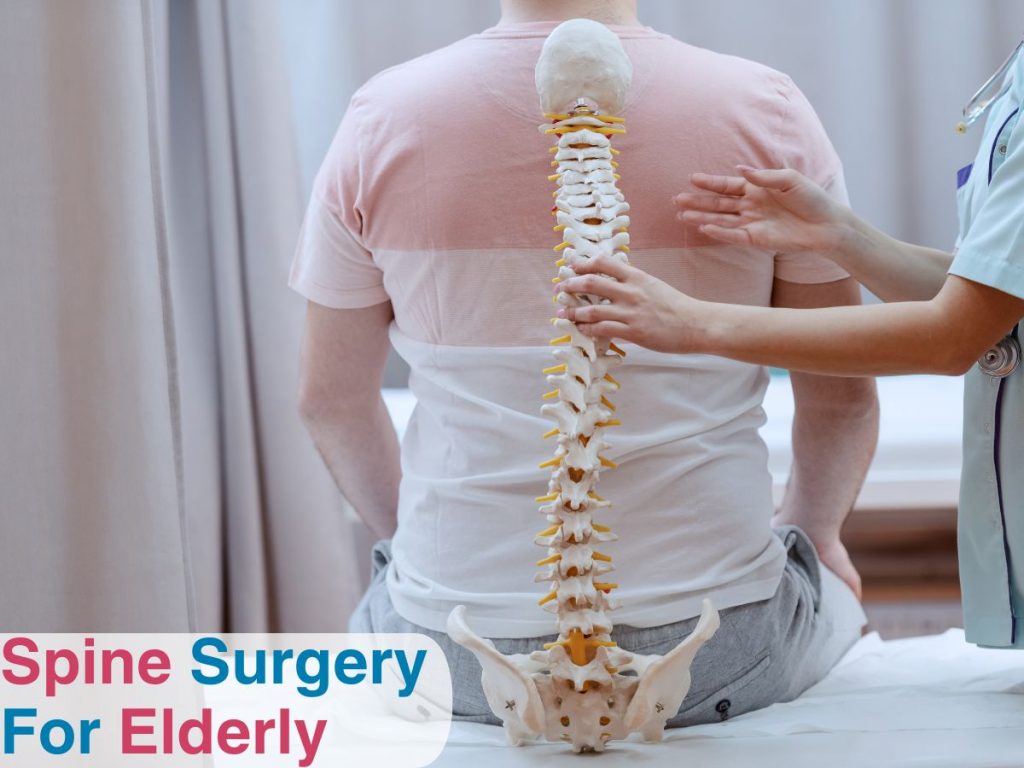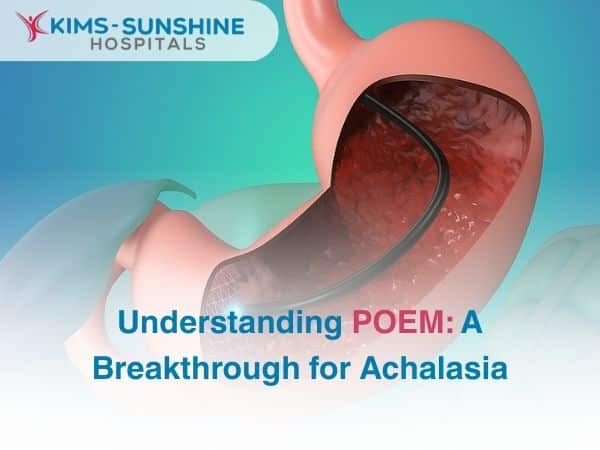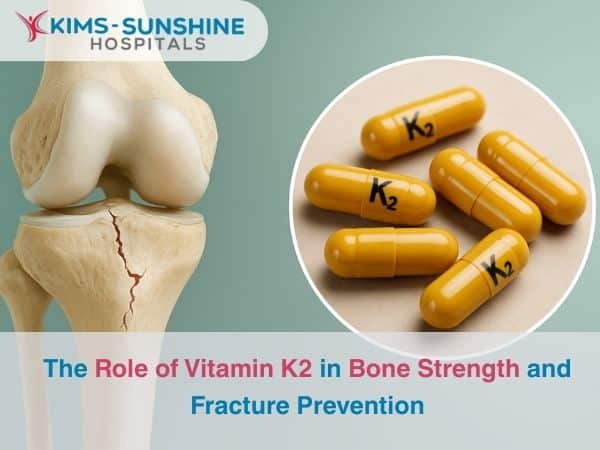
Spine Surgery For Elderly
BY Dr. Dinakar. A ,MBBS, D Ortho, DNB (Ortho)

Are you an elderly person?
Suffering from spine problems?
Looking to get benefited from your spine surgery?
If yes… Definitely, At our KIMS- Sunshine Hospital, you can get a better quality of elder life with your spine surgery.
A lot of factors in our daily life will affect all structural elements of the spine. The physiological, biochemical changes and acquired abnormalities fall, fractures are leads to spine-related health issues, neural diseases, walking difficulties, pain in the lower extremities and functional problems in the elderly.
The rise of new medical technology, advanced diagnostic methods and patient’s awareness are providing better spine surgeries for elders at an affordable cost. At KIMS- Sunshine Hospital, with your spine surgery, you will get a better quality of life even in your elder age.
Among all mammals with vertebrates, we humans are the only ones who can stand and sit upright? Thanks to our spine, a group of small bones fuse together to form the spine, which starts from the neck and extend to the buttocks. It supports the head, shoulders and upper body. Your spine plays another important role: The spine forms a tunnel for your spinal cord. This is a set of nerves that connects your brain to most of your body.
The number of elderly people in India continues to increase, there is an increase in age-related diseases, such as degenerative diseases of the lumbar spine, pain caused by lumbar spinal stenosis, and sometimes the pain is caused by the injury or a traumatic accident. Older patients often go to orthopaedics or primary care providers with back and lower leg pain.
Spinal surgery is one of the few options that geriatric patients can consider to relieve symptoms, but the literature that illustrates the safety and efficacy of spinal surgery in the elderly cannot be indecisive and is sometimes confusing.
The purpose of this article is to describe the spine, related spine degenerative disease, treatment provided at KIMS- Sunshine Hospital for spine in elderly, and results of spinal surgery in the elderly. Discover insights on spine surgery tailored for the elderly. Explore safety measures, recovery tips, and key considerations for a successful and comfortable procedure.
What Is Spine?
The spine extends in the middle of the trunk from the skull base to the coccyx, and plays an important role in our body because it keeps the upper body weight, provide posture while allowing movement, and flexibility, and protect the spinal cord.
The spine, also referred to as vertebral column or spinal column, is a column of 26 bones in the body of an adult, 24 separate vertebrae located between the cartilage cervical (1-7), thoracic (7-12), Lumbar (12-22) and additional two the sacrum and coccyx.
Problems Caused in Spine
Back pain that occurs suddenly and lasts for more than six weeks (acute) can be caused by falling or lifting weights, and by age. Back pain lasting more than three months (chronic) is less common than acute pain.
- Slipped disc Lumbar & Cervical
- Cervical Spondylosis
- Osteoarthritis
- Spinal Stenosis Lumbar & Cervical
- Sciatica
- Tumour
- Ankylosing Spondylitis
- Spinal Cord Injury
- Broken Neck or Back
- Spondylolisthesis
- Cauda Equina Syndrome
- Syringomyelia
- Interbody Fusions – Lumbar & Cervical
- Correction Of Spinal Deformities
- Vertebroplasty & Kyphoplasty
- Spinal Reconstruction
Risk factors of Spine Problems in the Elderly:
Anyone can get back pain, including children and adolescents. Avoid movements that bend or stretch your back. Use your body properly: These factors can increase the risk of developing back pain:
Age: Back pain is more common in the age of 30 to 40 years. As falls are more common in older age
Lack of exercise: Weak, unused muscles and no pressure on the back and abdomen can cause back pain.
Disease: Some types of arthritis, cancer, osteoporosis, and inflammation of the spinal cord can cause back pain.
Smoking: Blood flow is reduced to the lower spine by smoking, which prevents your body from delivering enough nutrients to the disks in your back. Smoking also slows healing.
Excess weight: Being overweight puts additional strain on your back
Improper lifting: Using your back instead of legs can cause back pain.
Psychological conditions: People who are suffering from depression and anxiety will have a higher risk of back pain.
Signs and Symptoms of Spinal Deformities:
- Neck, head or back severe pain or pressure
- Tingling or loss of sensation in the hand, fingers, feet or toes
- Partial or total loss of control over body parts
- Difficulty with balance and unable to walk
- Abnormal laryngeal sensation in the chest – pain, pressure
- Impaired breathe after an injury
- Any unusual growth of lumps on the head or spine
Diagnosis:
Back pain often arises without reason, which can be identified by a doctor with a test or research. Diseases that are commonly associated with back pain include:
- X-Ray
- Magnetic resonance imaging (MRI)
- CT scan with 3-D reconstruction Electromyography
- Nerve conduction velocity testing
Spine Surgical Treatment in the Elderly:
Non-Operative Treatment:
In patients without neurological deficits or acute symptoms worsening, the doctor will provide one or more non-surgical therapy surveys: Non-steroidal anti-inflammatory drugs, opioid analgesics, epidural drugs, flexibility and strengthening exercise programs, and patient education on exercise is useful in the treatment of acute lower back pain. Interventional procedures, such as corticosteroid injections and electrotherapy, can provide therapeutic benefits for certain patients.
the effect of surgical and non-surgical treatments, patients treated with surgery report greater satisfaction and improvement in symptoms and functional status compared to non-surgical treatment. If the patient does not show any more improvement in symptoms with extensive nonsurgical interventions, then surgery is recommended.
Spine Surgery Options for Elders
Many surgeons are reluctant to carry out the open-back procedure in adult patients because of the increased risk of complications. Commonly, old patients who undergo open back surgery required to stay in the hospital for several days, the treatment costs will be high, more often experience infections, life-threatening complications, or hospital visits in 30-days post-surgery.
But there’s good news for elderly patients who suffer from back and neck pain. Recent studies evidence suggests that minimally invasive spine surgery may offer elderly patients more options for spine care. The benefits of undergoing an outpatient procedure with MIS is minimal blood loss, less scarring, faster recovery time, and fewer postoperative risks. We at KIMS- Sunshine Hospital provides two types of surgeries for the spinal to treat older people. They are:
Minimally Invasive Spine Surgery MIS
Minimally Invasive Spine Surgery (MIS) is becoming increasingly popular among old patients. With an ageing population and the strong desire of all patients to remain physically active, this trend tends to continue. Previous studies have reported clinical results in elderly patients undergoing MIS surgery.
Overall, this surgery aims to use minimally invasive spinal surgery (MIS) to stabilize the spine and spine joints, and reduce pressure on the spinal cord, often as a result of disorders such as spinal instability, bone spurs, disc herniation, Scoliosis or spinal tumour.
Compare to open spine surgery. A minimally invasive surgical approach can be faster, safer, requires less recovery time, as it reduces muscle trauma and soft tissue and the following potential benefits:
- Smaller skin incisions (sometimes only 2 cm)
- Less blood loss than surgery
- Reducing the risk of muscle
- Reducing the risk of infection and postoperative pain
- Recovery faster after surgery and less rehabilitation
- Reduced dependence on painkillers after surgery
Also, some MIS are performed as outpatient procedures and uses only local anaesthetics; so there is little risk of an adverse reaction to general anaesthesia.
MIS procedures treat conditions:
- Degenerative disc disease
- herniated disc
- Lumbar spinal stenosis
- Spinal deformities
- spinal infection
- Spinal instability
- Vertebral compression fracture
- Spinal tumour
Working of minimally invasive in spine surgery
To do surgery for the spinal we should go through the spinal nerves, vertebrae and discs that are located deep inside the body, to do the surgery to the spinal area require access moving the muscle tissue out of the way. In general, this is facilitated by the use of an endoscope tool inserted into the body by a small incision, that helps the visualization of the inner body using a scope or a camera which scan, identify and treat any issues within the spinal cord.
Minimal Access Spinal Technologies MAST
Image credit: YouTube.com
Minimal Access Spinal Technologies (MAST) is used for Minimally invasive procedures. This can enable surgeons to successfully treat lower back pain and distortion with the fewest surgical disorders while achieving the same surgical goals with open surgery. This technology has been developed from advances in orthopaedic surgery with minimal access over the past two decades. Video cameras, X-rays, detailed anatomical images, computer-assisted navigation, specially designed instrument. The Accurate diagnostic tools provide an alternative to conventional open spine surgery, which helps reduce recovery time and pain.
The MAST procedure means that the surgeon with an imaging system, tiny cameras, and incisions no longer than a thumbnail can achieve the same results and goals as traditional operations. The surgeon is guided to reach the exact location of the spine by the special live-action X-rays machine and has a clear visualisation and localisation of the spinal problem. MAST offer surgeons the ability to work in smaller surgical areas with less tissue trauma. The potential benefits for patients through the MAST procedure can provide patients with physical, mental, emotional and aesthetic benefits that make surgery less daunting.
Potential Benefits of Patients from the MAST procedure:
- Return to normal activities faster
- Less postoperative pain
- Less damage to muscles and skin
- Easier rehabilitation
- Smaller scars
- Less blood loss
- Outpatient surgery in some patients
Conclusions
Spinal surgery for the treatment of lumbar spinal degenerative diseases and other spinal diseases can be safe in very old patients. Complication rates are higher than younger patients but may be acceptable if the potential benefits of the intervention are balanced. Careful treatment is very important, anaesthesia and surgery time must be kept to a minimum.
Cervical spine injury in elderly patients is usually associated with more than one persistent clinical instability and often occurs in the atlantoaxial complex.
When it comes to spine surgery for the elderly, finding the best care is paramount. At KIMS-Sunshine Hospitals, we understand the unique needs of our elderly patients. With the expertise of our skilled orthopedic team, led by the best orthopedic doctors near you, we ensure compassionate and tailored care. Our commitment to excellence has earned us the reputation of being the best orthopedic hospital in Hyderabad, providing comprehensive and specialized spine surgery solutions for the elderly. Your well-being is our priority.






